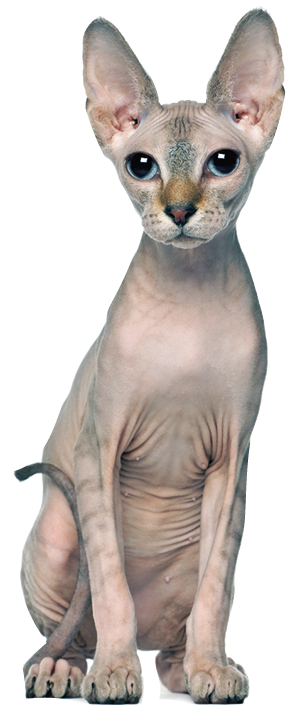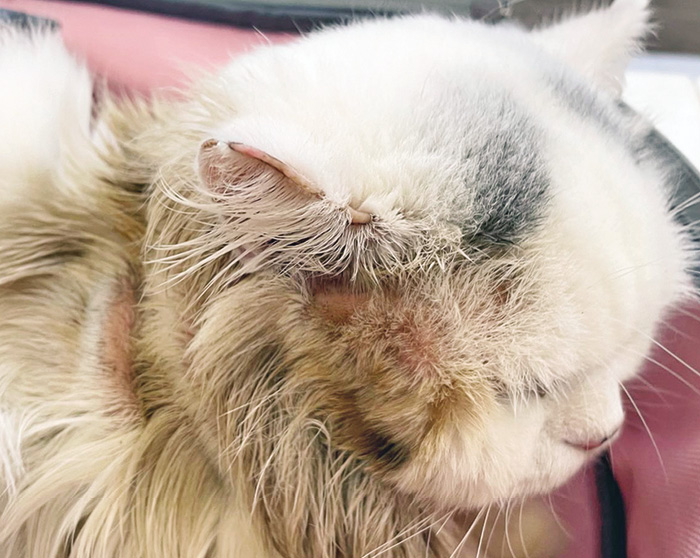Alopecia, which is complete or partial hair loss, is often seen in cats, but it is usually secondary to another problem. It is never normal and can take detective work to determine the cause.
An accurate history can help guide your veterinarian and keep costs for diagnostics to a minimum. That includes possible stress, such as a new pet added to the family, but true psychogenic alopecia is unlikely, says Katherine Houpt, VMD, professor emeritus of behavior at Cornell University College of Veterinary Medicine.
William Miller Jr., VMD, professor emeritus of medicine at the Cornell University College of Veterinary Medicine, agrees that feline dermatology problems are rarely behavior related: “Most, if not all, cats with hair loss have an underlying allergic condition such as a parasite, pollen, or food.”
Diagnosis
Your veterinarian will look to see if the hair loss is symmetrical and check the cat’s skin. Hair may be plucked for fungal cultures and skin scrapes taken to check for parasites. An impression smear may be done with a slide to look for yeast and/or bacteria in moist, inflamed areas.
A blood chemistry panel and complete blood count will be done to help eliminate underlying problems. Thyroid levels will be checked. Your veterinarian may even screen for cancer.
Typical Causes
Parasites rise to the top of any list of causes for alopecia. Fleas, chiggers, mites, and lice can cause your cat to lick or scratch, which commonly removes hair. Hair loss from parasites may leave bald patches with reasonably healthy skin beneath or may cause inflammation, infection, or ulcerated areas. In these cases, the hair loss may be due to fungal, yeast, or bacterial infections.
Treatments
As you’re likely aware, we have excellent medications to treat external parasites, ranging from oral to topical products.
Allergies are more difficult to control. Just as with dogs, cats can be allergic to foods, dust mites, and inhaled allergens such as pollens. Seasonal hair loss (not shedding, but more severe) is a strong indicator of allergies. A cat with flea allergy usually will respond to a strict parasite control program. And we mean strict: One flea bite can send these cats into serious itching and chewing fits.
Cats with food sensitivities and allergies often show ear inflammation as well, leading to hair loss around the head and neck.
Diagnosing food allergies is an involved process requiring a dedicated owner. Your cat will need to eat either a novel protein diet, which contains a protein source that he has never eaten before such as kangaroo or duck, or a hydrolyzed protein prescription diet. In a hydrolyzed diet, the proteins are broken into small components that are not recognized by the immune system. Importantly, during such a food trial, the cat must eat only these special diets, which means no treats, other cat food, or human food.
Atopy, a reaction to inhaled allergens, can be an equally challenging diagnosis. The gold  standard remains skin testing with multiple likely allergens, including various pollens. Immune serology—measuring levels of antibodies to specific allergens in the blood—may be substituted for skin testing in some cases.
standard remains skin testing with multiple likely allergens, including various pollens. Immune serology—measuring levels of antibodies to specific allergens in the blood—may be substituted for skin testing in some cases.
Once offending allergens are identified, you will be advised to either manage your cat so she does not come into contact with the allergen, use a desensitization treatment, or, especially if the problem is seasonal, control the symptoms for that period with corticosteroids and/or other medications.
Cause Dictates Treatment
Treatment of feline hair loss is directly related to the cause. Many cats will need short-term anti-inflammatory steroid therapy for comfort while the underlying causes are dealt with. Parasites need to be treated, including those found in the environment and on other pets. Allergens need to be eliminated, if possible, or managed while symptoms (primarily itching) are controlled with anti-inflammatory medications. Any secondary problems such as bacterial skin infections will need appropriate medications such as antibiotics.




